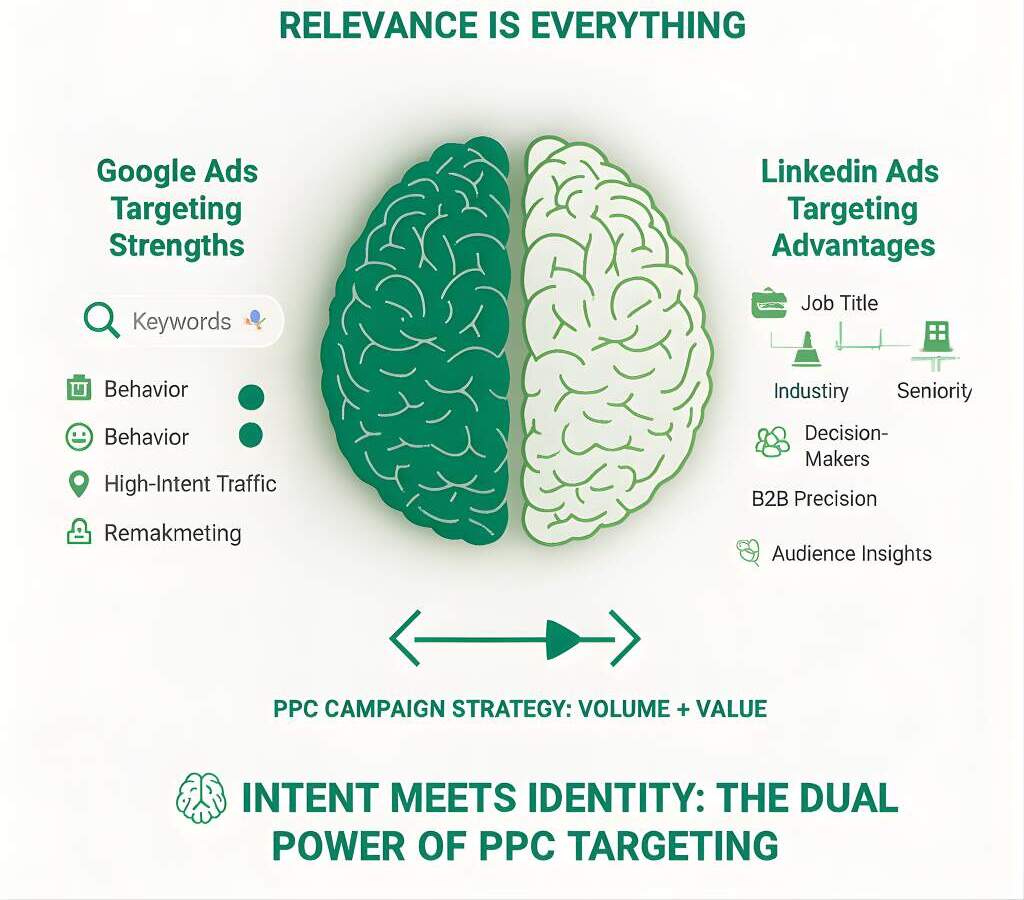PPC on Google vs LinkedIn Ads: Key Differences, Benefits & When to Use Each
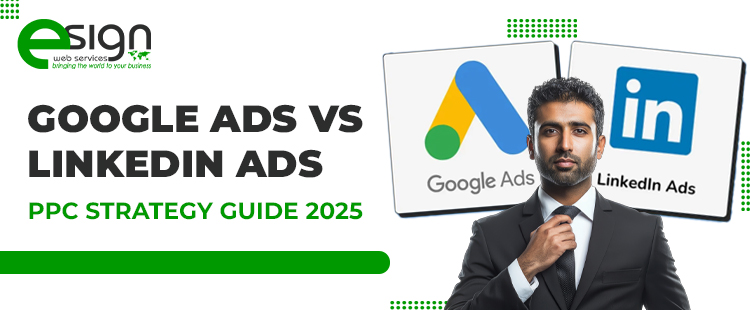
Key Takeaways
- Google Ads captures immediate intent and delivers scalable, data-driven conversions.
- LinkedIn Ads builds authority, trust, and high-quality B2B leads through professional targeting.
- Combine both for a full-funnel PPC strategy â awareness to action.
- Use Conversion Rate Optimization (CRO) and Audience Insights to refine performance.
- Prioritize ROI-based budget allocation and cross-platform retargeting.
- Measure success beyond clicks â focus on CPL, LTV, and pipeline impact.
- Strategic orchestration of both channels = higher visibility + smarter conversions.
In Pay-Per-Click Marketing, two platforms dominate most plans: Google and LinkedIn. Treat them as tools, not tribes. Google captures âI-need-this-nowâ queries at scale; LinkedIn reaches professional buyers when theyâre primed for ideas, not just purchases. If youâre debating Google Ads vs LinkedIn Ads, youâre really deciding how to balance Search Engine Marketing (SEM) with professional identity targeting.
The right answer depends on your productâs buying cycle, ACV, and sales motion. Short cycle, high intent? Search first. Long cycle, multiple stakeholders? Start Advertising on LinkedIn to shape demand and then harvest it via search. What follows isnât cheerleadingâitâs a clear PPC campaign strategy you can ship this quarter: how the platforms differ, where each wins, and how to combine them to lift Click-Through Rate (CTR), lower CAC, and tighten Conversion Rate Optimization.
Search Mindset and Professional Context
Google is a heat-seeking missile for intent. Users type problems in plain language; ads intercept with solutions. Thatâs why search converts: urgency is baked into the query. LinkedIn is different. People arrive to learn, network, and evaluate ideas in a professional context. Theyâre not âshopping,â but theyâre open to credible signalsâbenchmarks, case studies, and frameworks. If you sell a complex B2B offer, this context is priceless. You can seed narratives, qualify by seniority, and warm accounts before they ever Google you.
Framed this way, Google Ads vs LinkedIn Ads is less either/or and more âwhat moment are we targeting?â When intent already exists, SEM delivers efficient clicks and strong Lead Conversion Strategies. When intent doesnât existâor when committees need consensusâAdvertising on LinkedIn sets the agenda and influences the criteria early. Plan around moments, not channels: search catches active demand; LinkedIn manufactures tomorrowâs demand.
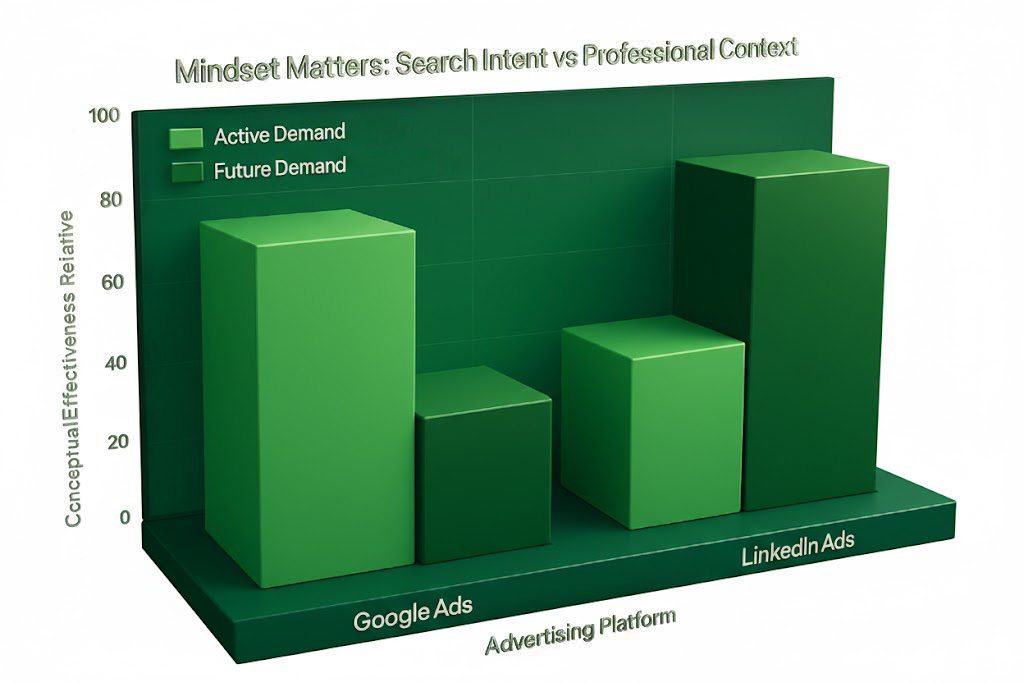
Audience Targeting: Relevance is Everything
In Pay-Per-Click Marketing, hitting the right Audience matters more than hitting a large one. Both Google Ads and LinkedIn Ads deliver precision, but they do it differently â one focuses on intent, the other on identity.
Google Ads Targeting Strengths
- Targets users based on keywords, behavior, and location â ideal for Search Engine Marketing.
- Great for capturing high-intent traffic ready to convert.
- Uses layered targeting, such as remarketing and demographics, to lift Click-Through Rate (CTR) and optimize ROI.
LinkedIn Ads Targeting Advantages
- Focuses on job title, industry, and seniority â perfect for B2B precision.
- Excellent for Advertising on LinkedIn to reach decision-makers before they search.
- Generates fewer but higher-quality leads through deep Audience Insights.
Google Ads finds people searching for solutions, while LinkedIn Ads reaches those shaping the decisions. Combine both in your PPC Campaign Strategy to balance volume with value and drive smarter Lead Conversion Strategies.
Ad Formats: Creativity Meets Strategy
Formats shape outcomes. Google gives you Search, Responsive Search, Performance Max, Display, YouTube, and Shoppingâa full stack to meet users from query to video to remarketing. That variety supports rigorous Conversion Rate Optimization testing: headlines, sitelinks, assets, video hooks, product feeds. LinkedIn favors native storytelling: Sponsored Content (single image, carousel, video), Document Ads, Lead Gen Forms, and Message Ads. The feed is designed for expert opinions, POV threads, and content offers, making LinkedIn ideal for Lead Generation Strategies that capture attention before requesting a meeting. Use Google when a specific problem/keyword aligns with a direct response page. Use LinkedIn when a strong narrative plus social proof earns the click. Together, they let you tell the story (LinkedIn), then close the loop (Google).
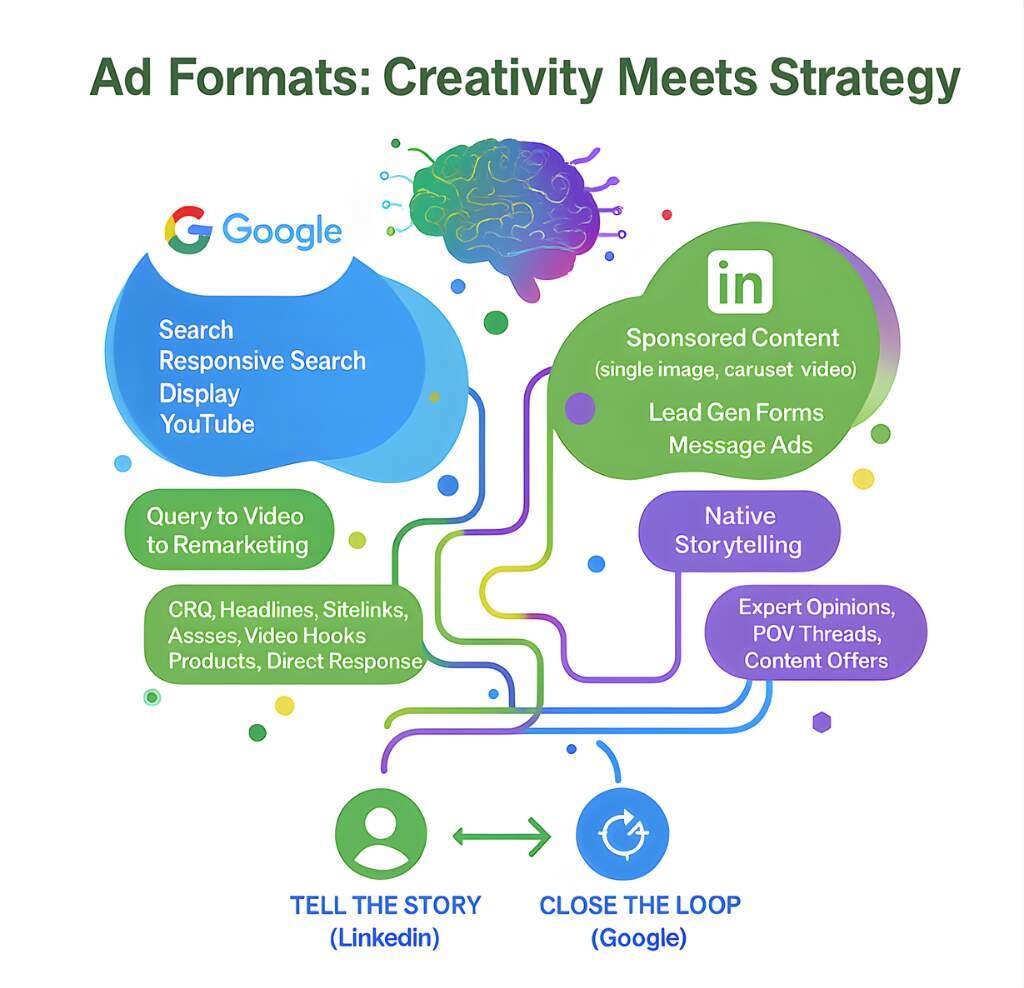
Budget and ROI: Cost Depends on Context
Expect different economics across platforms. In many industries, Google Search CPCs are lower than LinkedInâs professional clicks. However, a higher LinkedIn CPC can still make sense if lead quality and deal size increase accordingly â thatâs not semantics, itâs smart unit economics. Always track CPL, SQL rate, pipeline velocity, and LTV/CAC ratio, not just click price.
If you sell high-ticket products (e.g., $10K+ ACV) and deal with multi-stakeholder approvals, paying more per LinkedIn ad click to reach senior decision-makers often delivers better ROI. Conversely, if your AOV is moderate and buying cycles are short, Googleâs scalable search intent becomes your profit engine.
The mature approach to comparing Google Ads vs LinkedIn Ads is scenario-based: model CAC and CPL by segment, then allocate budgets dynamically to the channel delivering the highest return. Protect spend efficiency with bid caps, audience negatives, and frequency controlsâand reinvest only when marginal CPL remains profitable over at least three cycles.
This is disciplined Pay-Per-Click Marketing, not guesswork.
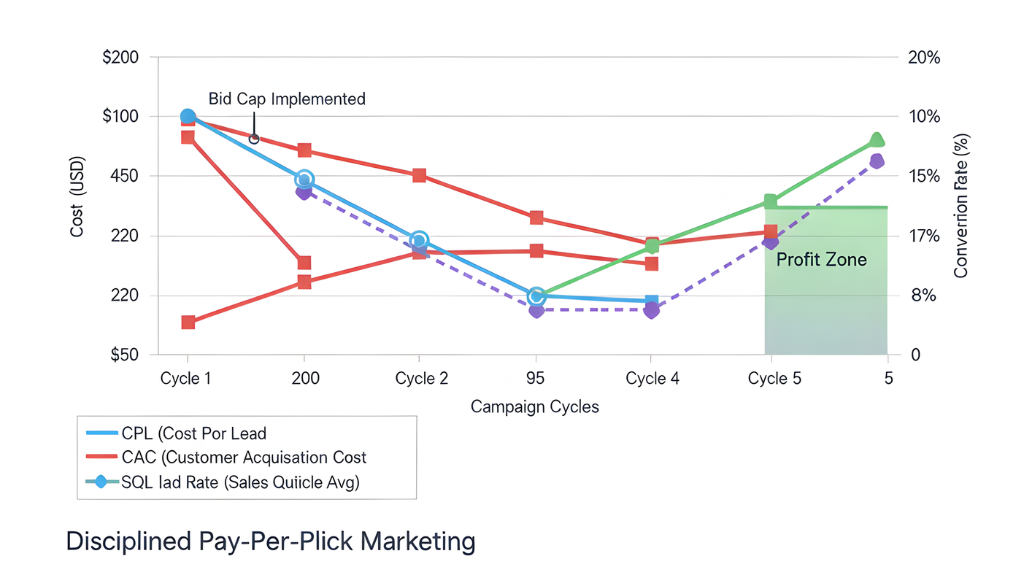
     ROI Optimization Insights
- Segment campaigns by AOV and cycle length for targeted ROI modeling.
- Apply bid caps and negative audiences to protect ad spend efficiency.
- Reinvest only when marginal CPL remains profitable across 3 cycles.
- Track pipeline velocity alongside CPL and CAC for sharper performance clarity.
Funnel Focus: Where Each Platform Excels
Map platforms to stages. Bottom-funnel actionsâtrials, demos, callsâbelong to Google Search and high-intent YouTube queries. Mid-funnel educationâcomparisons, ROI explainers, buyer guidesâworks brilliantly on LinkedIn with Document Ads and Lead Gen Forms. Top-funnel authorityâoriginal research, frameworks, and case storiesâthrives in the LinkedIn feed where comments amplify reach and Audience Insights guide iteration. Use LinkedIn to introduce your POV, retarget engagers with Google Display/YouTube, and close deals via exact-match search terms mapped to pain-first landing pages. Expect CTRs to be higher on search and view-through to matter more on social. Thatâs fineâattribute correctly, then optimize sequentially. Stitching stages beats channel silos and compounds Lead Conversion Strategies over time.
Performance Tracking: Measuring What Matters
Measure people and behavior, not vanity. On Google, wire Search Engine Marketing fundamentals: granular conversion actions, enhanced conversions, query-level reporting, and page-speed diagnosticsâeach influences Click-Through Rate (CTR) and CPC. On LinkedIn, deploy the Insight Tag, build Matched Audiences, and read the Audience Insights reports for title, industry, and company engagement. Then marry ad data with CRM: campaign â lead â stage â revenue. Only then can you judge Conversion Rate Optimization changes with confidence. If you canât see the pipeline, you canât scale the budget. Adopt a weekly operating rhythm: analyze placement, query intent, creative hooks, and offer friction; run clear A/Bs; and implement one improvement across the ad, page, or offer each cycle. Small, relentless lifts beat sporadic overhauls.
Smart Matchups: When to Use Google Ads vs LinkedIn Ads
Think of Pay-Per-Click Marketing as a strategy, not a rivalry. Both platforms are elite players â they just play different positions.
Round 1 â Instant Impact vs Long Game
Google Ads captures people ready to act. Every search is in motion â ideal for e-commerce, local services, or time-sensitive campaigns. Pair tight keyword clusters with optimized landing pages for fast Conversion Rate Optimization wins.
LinkedIn Ads builds momentum over time. It targets professionals while they learn, connect, and plan. Perfect for Lead Generation Strategies, thought leadership, and B2B nurturing.
Round 2 â Reach vs Relevance
Google casts the widest net through Search Engine Marketing and remarketing. Use it to scale fast and gather behavioral data for refining your PPC Campaign Strategy.
LinkedIn focuses the beam. Its Audience Insights let you filter by job title, industry, and seniorityâgreat for hitting decision-makers who actually sign the deal.
Round 3 â Budget & Payoff
Google usually wins on CPC ($1-$3), giving volume and testing freedom.
LinkedIn costs more ($5-$15) but delivers fewer, higher-value clicks that often close larger deals. Think efficiency vs precision, not cheap vs expensive.
Quick Strategy Tip:Warm prospects with Advertising on LinkedIn, then capture their intent later with Google Ads. Itâs not a fightâitâs a relay. One builds awareness, the other seals conversions.
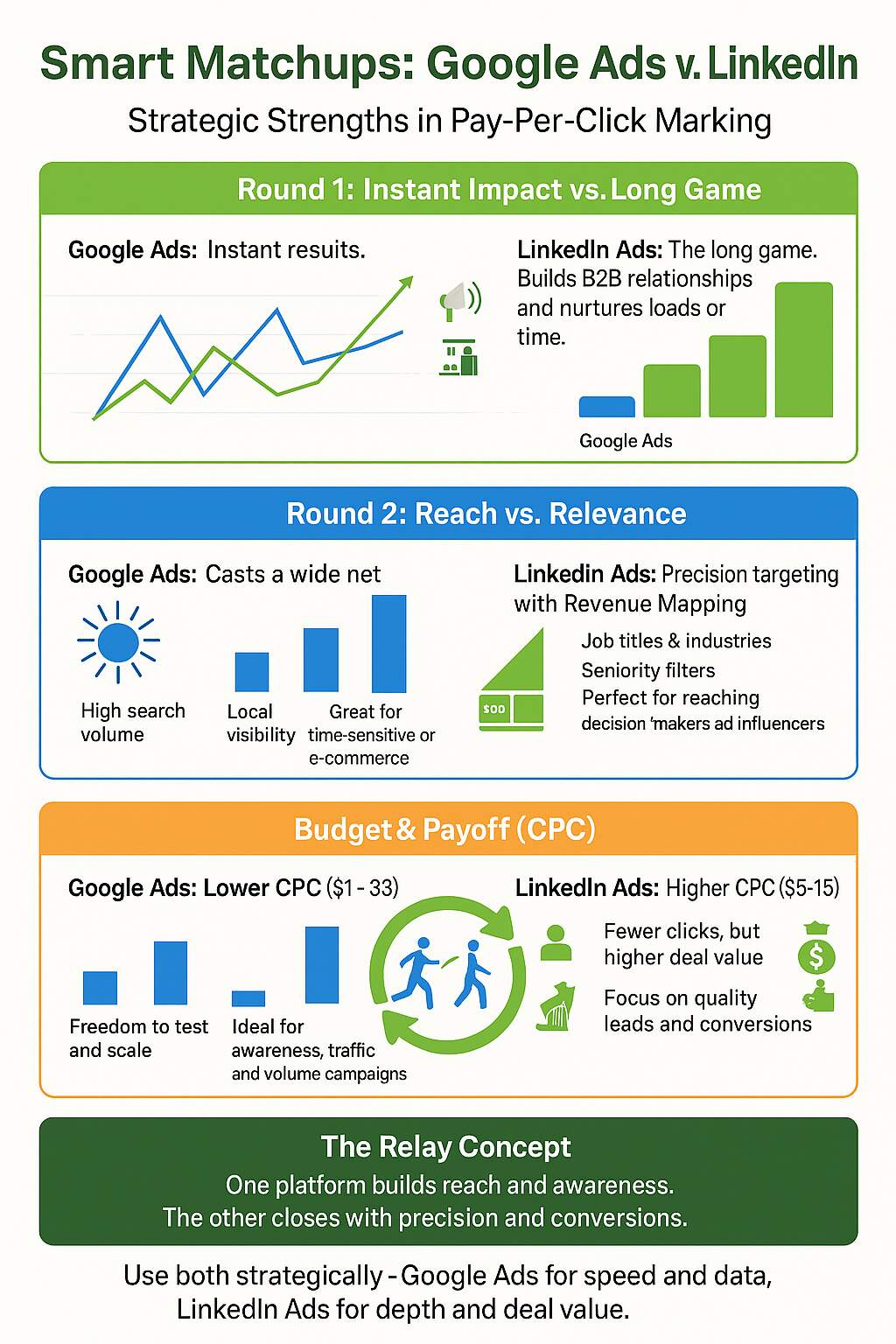
Smarter Together: The Dual-Platform Strategy
The winning move is orchestration. Warm your ICP on LinkedIn with narrative content and credibility cues (logos, outcomes, quotes). Build Matched Audiences from engagers. Then meet them again on Google when they search category or competitor termsâyour brand will âfeelâ familiar, lifting CTR and lowering acquisition friction. Retarget non-converters with value (calculator, teardown, diagnostic) rather than more âbook a demo.â This dual approach compounds Lead Conversion Strategies: social plants and nurtures; search harvests and closes. Track assisted conversions and view-through to avoid under-funding the top of the funnel that made the bottom-funnel cheap. Allocate the budget by marginal CPL to keep spending honest.
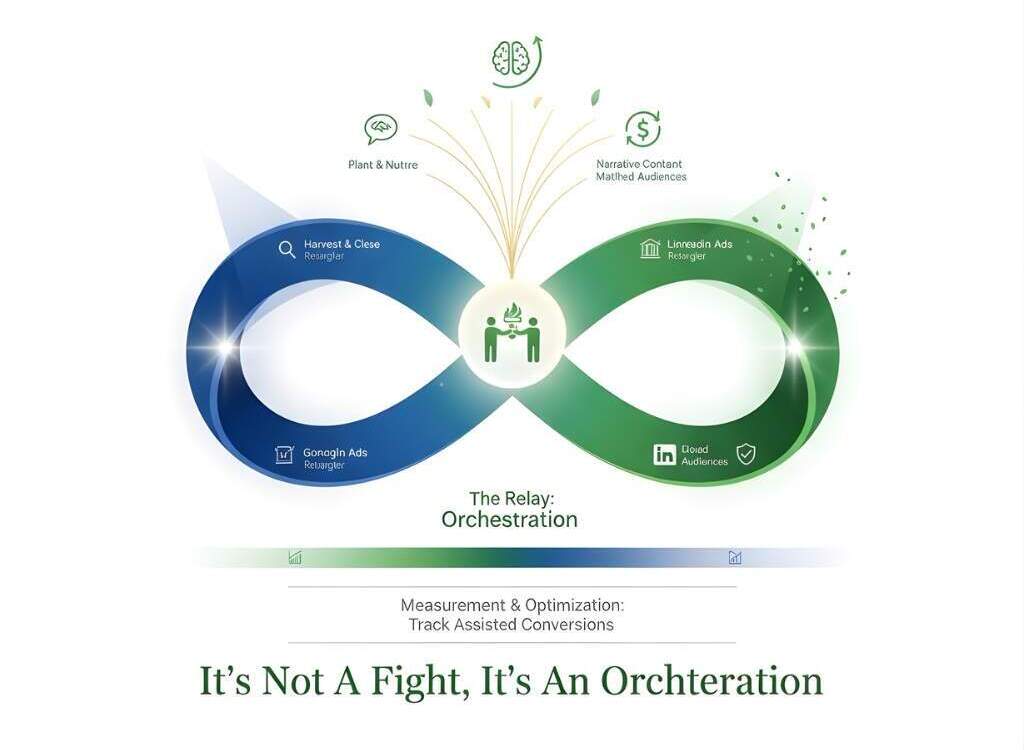
Action Plan: PPC Checklist for Smarter Campaigns
- Nail ICP: role, industry, company size, pains, and triggers (Audience Insights).
- Map journeys: LinkedIn for awareness/education; Google for intent capture (Search Engine Marketing).
- Offers first: calculators, ROI sheets, mini-cases beat generic eBooks (Lead Generation Strategies).
- Wire tracking: GA4 + LinkedIn Insight Tag + CRM to revenue (Conversion Rate Optimization).
- Test weekly: one ad hook, one landing friction fix, one audience tweak.
- Budget by marginal CPL and pipeline, not hunches.
- Retarget thoughtfully: value â value â ask (not ask â ask â ask).
- Report on CTR, CVR, pipeline, LTV/CACânot clicks alone.
Overview: Different Platforms, Shared Purpose
In the evolving world of Pay-Per-Click Marketing, thereâs no single winner between Google Ads and LinkedIn Ads â only different strengths serving one shared goal: better visibility, stronger leads, and smarter conversions. Google captures search intent with speed and scale; LinkedIn shapes trust, credibility, and professional reach. Together, they bridge awareness and action, driving campaigns that not only convert but also connect. The future of PPC Campaign Strategy isnât about competition â itâs about synchronization. The brands that master both intent and identity will own tomorrowâs search and social space.
Ready to Build Your Own Dual-Engine PPC Strategy?
Reach out to eSign Web Services and let them design campaigns where Google fuels the clicks and LinkedIn shapes the conversations.
Your Audience isnât choosing one platform â why should you?
Letâs build a synergized PPC funnel that turns awareness into authority and traffic into trust.
Frequently Asked Questions (FAQs)
1. What does a Pay-Per-Click Marketing strategy involve?
A Pay-Per-Click Marketing strategy involves creating targeted ads that appear when potential customers search or browse online. Businesses pay only when users click, making it a cost-effective way to drive traffic, leads, and measurable engagement across digital platforms.
2. How can Audience Insights improve ad performance?
Audience Insights reveal who engages with your adsâby job title, interests, or behavior. Understanding these patterns helps refine targeting, personalize ad messaging, and increase overall engagement and conversion rates with better-aligned creative strategies.
3. Why is Conversion Rate Optimization crucial in PPC?
Conversion Rate Optimization ensures your ad clicks translate into real results. By improving landing pages, removing friction, and aligning messaging with user intent, marketers can increase conversions without raising ad spend.
4. How often should PPC campaigns be optimized?
Effective PPC campaigns need weekly or bi-weekly optimization. Reviewing performance metrics like CTR, CPC, and conversion data allows marketers to adjust bids, creatives, and targeting for steady growth and maximum ROI.
5. What are some strong Lead Generation Strategies for PPC?
Offering value-driven contentâlike ROI calculators, case studies, or product demosâhelps capture quality leads. Pairing these offers with compelling ad copy and well-structured landing pages can significantly improve form fills and lead quality.
6. How does Search Engine Marketing support brand visibility?
Search Engine Marketing boosts visibility by placing your ads where your audience is actively searching. It ensures your brand appears at the top of relevant search results, increasing credibility, awareness, and immediate engagement opportunities.
7. Why should marketers focus on Click-Through Rate (CTR)?
CTR shows how effectively an ad attracts attention. A high CTR means your message resonates with users. Monitoring it helps refine headlines, visuals, and calls-to-action to continually improve engagement and ad quality.
8. How can a business lower its Cost Per Lead (CPL)?
Businesses can lower CPL by optimizing targeting, improving ad relevance, and using retargeting campaigns. Testing multiple ad creatives, refining keywords, and enhancing landing page experience also reduce wasted clicks and increase profitability.
9. What makes storytelling effective in PPC campaigns?
Storytelling humanizes your ads by connecting emotionally with your audience. Sharing authentic success stories, client outcomes, or relatable challenges builds trust, encourages engagement, and strengthens brand recall across digital touchpoints.
10. How does data tracking enhance PPC Campaign Strategy?
Data tracking tools like GA4 and CRM integrations help marketers trace the full journeyâfrom ad click to conversion. This insight supports smarter budgeting, better segmentation, and continuous improvement across all ad campaigns.


